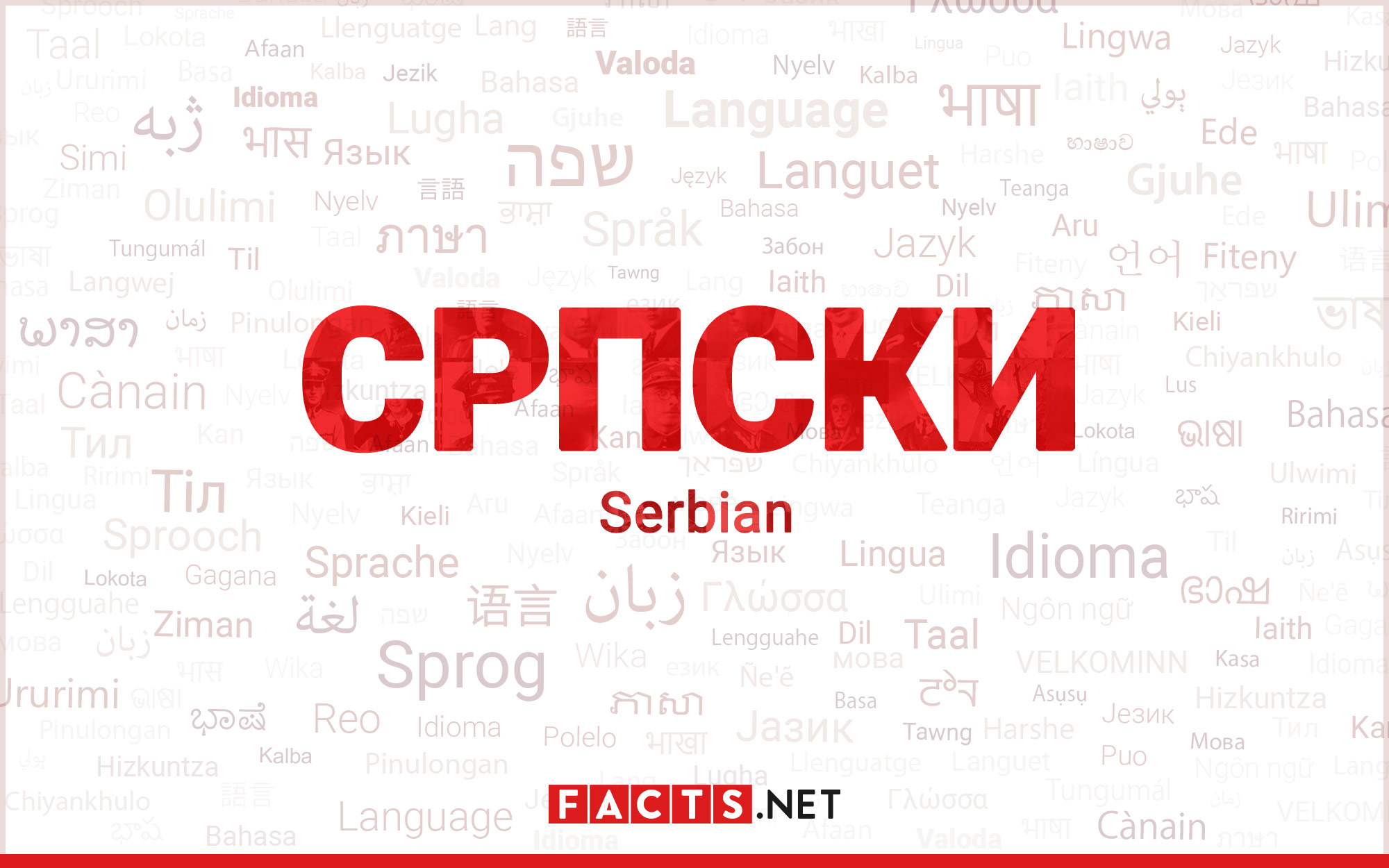
Serbian is a fascinating language that is spoken by millions of people in the Balkans. Whether you are a language enthusiast or simply curious about different cultures, you’ll be amazed by the rich history, unique characteristics, and interesting facts about the Serbian language. In this article, we will explore 20 mind-blowing facts that will give you insights into the beauty and complexity of Serbian. From its Slavic roots to its Cyrillic script, Serbian offers a remarkable linguistic journey that is worth exploring. So, fasten your seatbelts and get ready to dive into the world of Serbian language and discover some astonishing facts that will leave you in awe. Let’s explore the linguistic wonders of Serbian!
Key Takeaways:
- Serbian is a fascinating language spoken in several Balkan countries, with a unique dual alphabet and rich literary tradition. It’s also mutually intelligible with other South Slavic languages, making it a gateway to Balkan culture and history.
- Learning Serbian opens doors to a vibrant online community and a growing number of language learners worldwide. With its rich history and unique features, the future of the Serbian language looks promising for generations to come.
Serbian is an official language in Serbia, Bosnia, and Herzegovina, Montenegro, and Croatia.
Serbian is widely spoken and recognized as an official language in several countries in the Balkans, making it an important language in the region.
Serbian uses both the Latin and Cyrillic alphabets.
One of the unique aspects of the Serbian language is that it can be written using either the Latin or the Cyrillic script. This dual writing system reflects the historical influence of both Western and Eastern civilizations.
Serbian has interesting loanwords from other languages.
Throughout its history, Serbian has borrowed words from various languages, such as Turkish, German, and French. This linguistic borrowing enriches the vocabulary and adds depth to the language.
Serbian has a rich literary tradition.
Serbian literature dates back centuries and has produced influential writers such as Ivo Andri?, who won the Nobel Prize in Literature in 1961, and Dositej Obradovi?, one of the key figures of the Serbian Enlightenment.
The Serbian language has grammatical cases.
Similar to other Slavic languages, Serbian has a system of grammatical cases. This means that nouns, pronouns, and adjectives change their forms depending on their role in the sentence.
Serbian has three grammatical genders.
Unlike many other languages that have only two genders (masculine and feminine), Serbian has an additional neuter gender. This adds complexity to the language but also allows for greater precision in expression.
Serbian has a unique way of forming diminutives.
In Serbian, diminutives can be formed by adding suffixes to nouns, adjectives, and even names. This provides speakers with a wide range of expressions to convey endearment, affection, or simply to make something sound smaller or cuter.
Serbian has a distinctive word order.
While Serbian has a relatively flexible word order, it typically follows the subject-verb-object (SVO) pattern. However, due to the flexibility of the language, different word orders can be used to convey emphasis or other nuances.
Serbian has a complex system of verb conjugation.
The Serbian language has a vast number of verb forms, including tenses, moods, and aspects. Conjugating verbs can be challenging for learners, but it allows for precise expression of various actions and states.
The Serbian language has a rich collection of proverbs and idioms.
Proverbs and idioms play an important role in Serbian culture and language. These expressions offer insights into the values, beliefs, and wisdom of the Serbian people.
Serbian has regional dialects.
Across Serbia and neighboring countries, there are various regional dialects of Serbian. These dialects differ in pronunciation, vocabulary, and grammar, adding diversity to the language.
Serbian is mutually intelligible with other South Slavic languages.
Speakers of Serbian can typically understand and communicate with speakers of other South Slavic languages, such as Croatian and Bosnian, due to their shared linguistic roots.
Serbian has a relatively straightforward pronunciation system.
Unlike some other languages, Serbian has a consistent and phonetic pronunciation system. Once the basic rules are understood, it becomes easier to read, write, and speak Serbian.
Serbian has a strong influence from Old Church Slavonic.
Old Church Slavonic, an ancient Slavic language used in religious texts, has had a significant impact on the vocabulary and grammar of the Serbian language.
Learning Serbian can open doors to Balkan culture and history.
By learning Serbian, individuals gain access to an incredibly rich cultural heritage, including traditions, music, literature, and history that are unique to the Balkan region.
Serbian is a language of beautiful poetry.
With its rich vocabulary, intricate grammar, and melodic sound, Serbian is well-suited for poetry. Many renowned Serbian poets have crafted stunning verses in their native language.
Serbian has distinctive pronouns of address.
Unlike many other languages, Serbian has various pronouns of address to show respect and formality when speaking to different individuals. This cultural aspect is deeply ingrained in the language.
Serbian has a vibrant online community.
The Serbian language has a strong online presence, with numerous websites, forums, and social media platforms dedicated to promoting the language, connecting learners, and engaging in discussions.
Serbian has a growing number of language learners worldwide.
Due to the interest in Balkan culture and the increasing availability of resources, Serbian has gained popularity among language learners around the world, leading to a growing community of Serbian speakers.
The future of the Serbian language looks promising.
With its rich history, unique features, and dedicated speakers, Serbian continues to evolve and thrive, ensuring its relevance for generations to come.
Conclusion
In conclusion, the Serbian language is a fascinating and unique linguistic treasure. With its rich history, complex grammar, and distinct dialects, Serbian truly stands out among the world’s languages. We’ve explored 20 mind-blowing facts about Serbian, from its Cyrillic alphabet and extensive vocabulary to its influences from other languages and cultural significance.Whether you’re interested in languages, history, or simply expanding your knowledge, delving into the intricacies of Serbian will undoubtedly leave you amazed. So, why not embark on a journey of discovery by exploring this captivating language? You’ll unlock a world of linguistic wonders and gain a deeper appreciation for the cultural heritage of Serbia.Remember, learning a new language not only expands our communication abilities but also broadens our horizons and fosters cultural understanding. So, embrace the beauty of Serbian, and enjoy the endless possibilities that come with immersing yourself in its unique linguistic landscape.
FAQs
Q: How many people speak Serbian?
A: It is estimated that around 12 million people worldwide speak Serbian.
Q: Is Serbian a difficult language to learn?
A: Like any language, Serbian requires dedication and practice. Its grammar can be complex, especially for speakers of non-Slavic languages. However, with the right resources and commitment, it is definitely learnable.
Q: Are there different dialects of Serbian?
A: Yes, there are several dialects of Serbian, including the Shtokavian, Torlakian, and Macedonian dialects. These dialects differ primarily in pronunciation, vocabulary, and certain grammatical rules.
Q: How similar is Serbian to other Slavic languages?
A: Serbian is a South Slavic language and shares similarities with other languages in this group, such as Croatian, Bosnian, and Montenegrin. While they are mutually intelligible to a large extent, each language has its own distinct features.
Q: Can I learn Serbian online?
A: Absolutely! There are numerous online resources, language courses, and apps available that can assist you in learning Serbian. These platforms offer lessons, exercises, and interactive tools to help you develop your language skills at your own pace.
Q: Is Serbian written using the Latin or Cyrillic alphabet?
A: Serbian can be written using both the Latin and Cyrillic alphabets. The Cyrillic script is more commonly used, particularly in official documents, while the Latin script is often used in everyday communication.
Immersing yourself in the fascinating world of the Serbian language is just the beginning of your journey into the rich tapestry of Serbian culture. From traditional customs to modern-day life, there's so much more to explore about this captivating Balkan nation. Why not take a deeper dive into the intriguing aspects of Serbian culture that make it truly unique? You'll be amazed by the hidden gems waiting to be discovered.
Was this page helpful?
Our commitment to delivering trustworthy and engaging content is at the heart of what we do. Each fact on our site is contributed by real users like you, bringing a wealth of diverse insights and information. To ensure the highest standards of accuracy and reliability, our dedicated editors meticulously review each submission. This process guarantees that the facts we share are not only fascinating but also credible. Trust in our commitment to quality and authenticity as you explore and learn with us.


